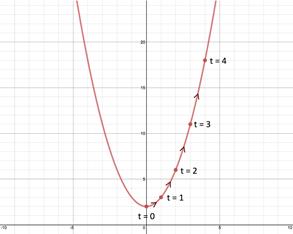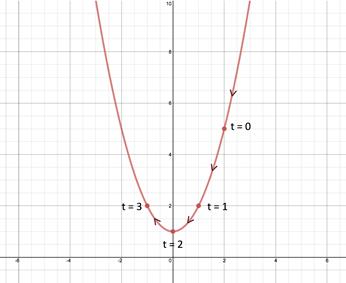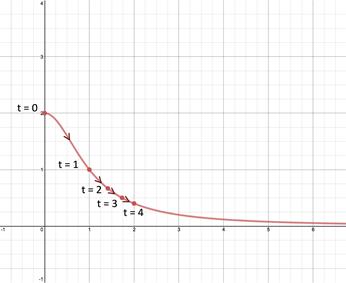Finding Parametric Equations for a Graph
|
First Parametric equation |
Second Parametric Equation |
Rectangular Equation |
|
|
y = t |
|
|
|
2y = t |
x = (2y)2 - 4
|
To find a set of parametric equations for the graph represented by y = x2 + 2 given t = x + 2, let t = x. Switching the roles of t and x in this equation gives one of the parametric equations:
Now substitute the expression for x into the rectangular equation, y = x2 + 2 to obtain the second parametric equation.
Thus the set of parametric equations for the graph represented by y = x2 + 2 is,
Now that both parametric equations have been determined, the overall graph can be drawn with selected values for the parameter.
|
t |
-2 |
-1 |
0 |
1 |
2 |
|
x = t + 2 |
0 |
1 |
2 |
3 |
4 |
|
y = t2 + 4t + 6 |
2 |
3 |
6 |
11 |
18 |

GUIDELINES FOR FINDING THE PARAMETRIC EQUATIONS FOR A GRAPH:
1. Take the parameter equation and switch the roles of the parameter and the other variable. This will result in one parametric equation.
2. Substitute the expression for the variable in Step 1 into the rectangular equation. This will result in the second parametric equation.
3. Sketch the curve.
Let's try a couple of examples.
|
Step 1: Take the parameter equation and switch the roles of the parameter and the other variable. Let t = x and rewrite the parameter equation by switching t and x. |
t = 2 - x Original x = 2 - t Switch t and x |
|||||||||||||||
|
Step 2: Substitute the expression for the variable in Step 1 into the rectangular equation |
Original Substitute Square Add |
|||||||||||||||
|
Step 3: Sketch the curve. List the two parametric equations and sketch a graph locating points at and indicate the orientation of the curve. Rectangular Equation: Parametric Equations: x = 2 - t,
|
||||||||||||||||
|
Step 1: Take the parameter equation and switch the roles of the parameter and the other variable. |
Original Switch t and x |
||||||||||||||||||
|
Step 2: Substitute the expression for the variable in Step 1 into the rectangular equation |
Original Substitute Square |
||||||||||||||||||
|
Step 3: Sketch the curve. List the two parametric equations and sketch a graph locating points at t = {0, 1, 2, 3, 4} and indicate the orientation of the curve. Rectangular Equation: Parametric Equations: ,
Note that the domain of the graph is because the domain of the parametric equation, , limits x to values of zero or greater. |
|||||||||||||||||||
|
Related Links: Math algebra Parametric Equations: Derivatives Inverse Functions: Graphs Pre Calculus |
To link to this Finding Parametric Equations for a Graph page, copy the following code to your site:


